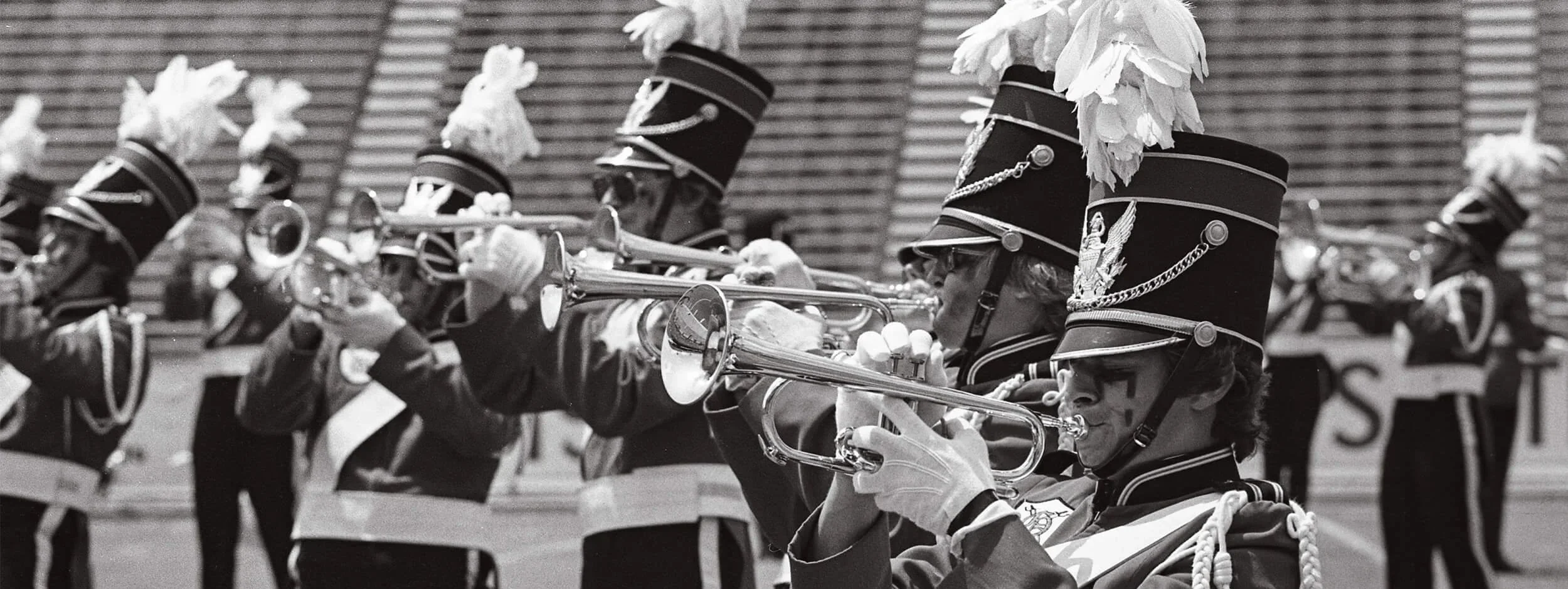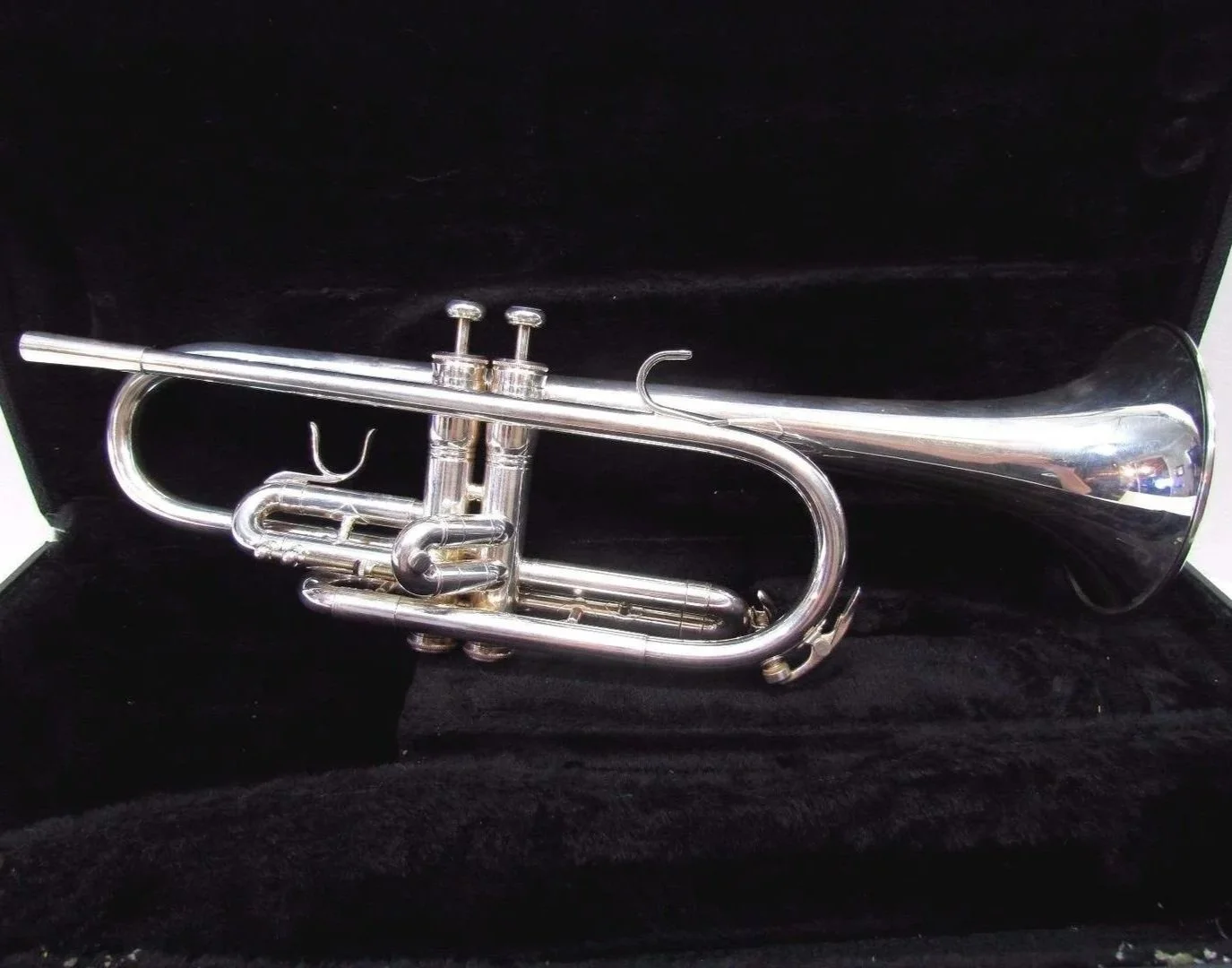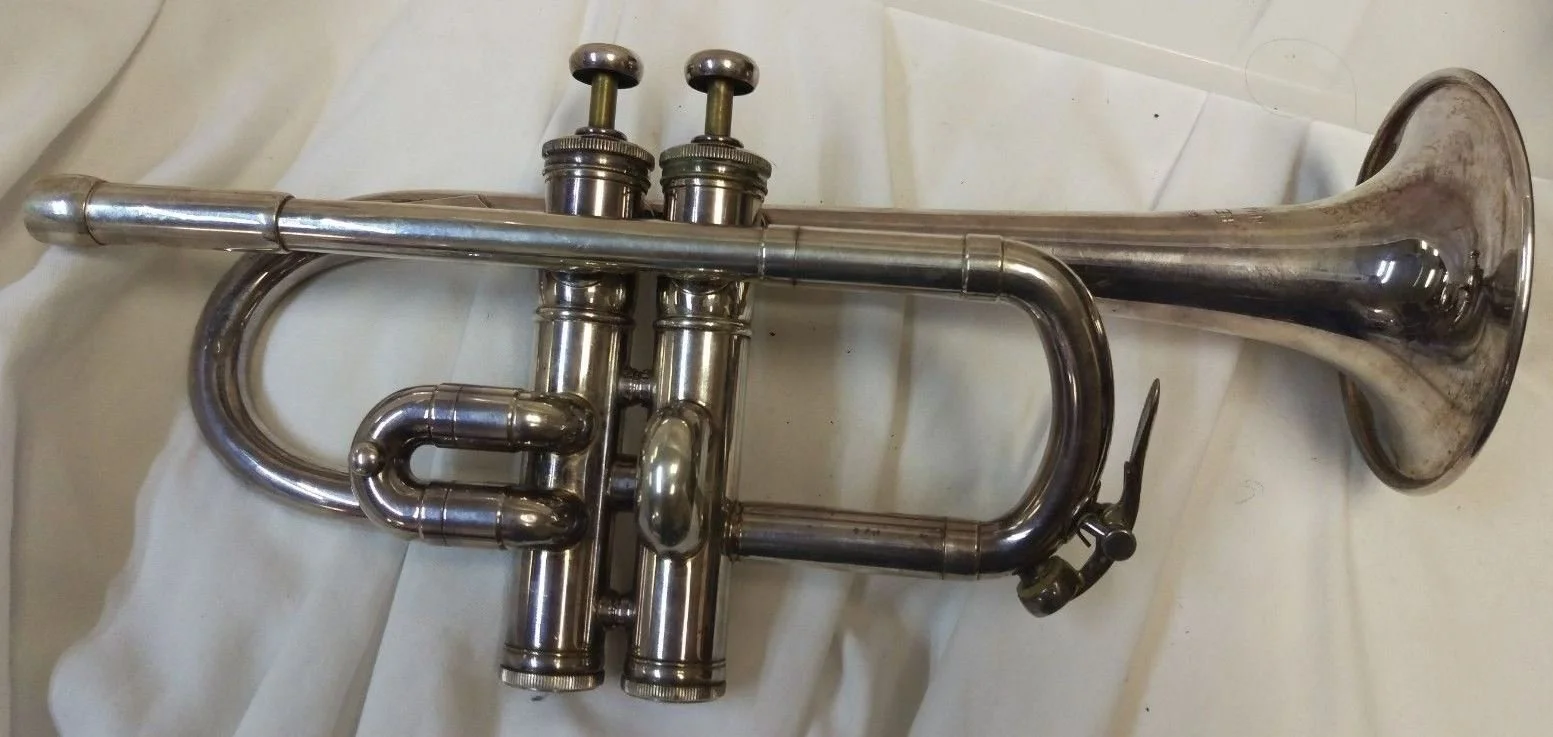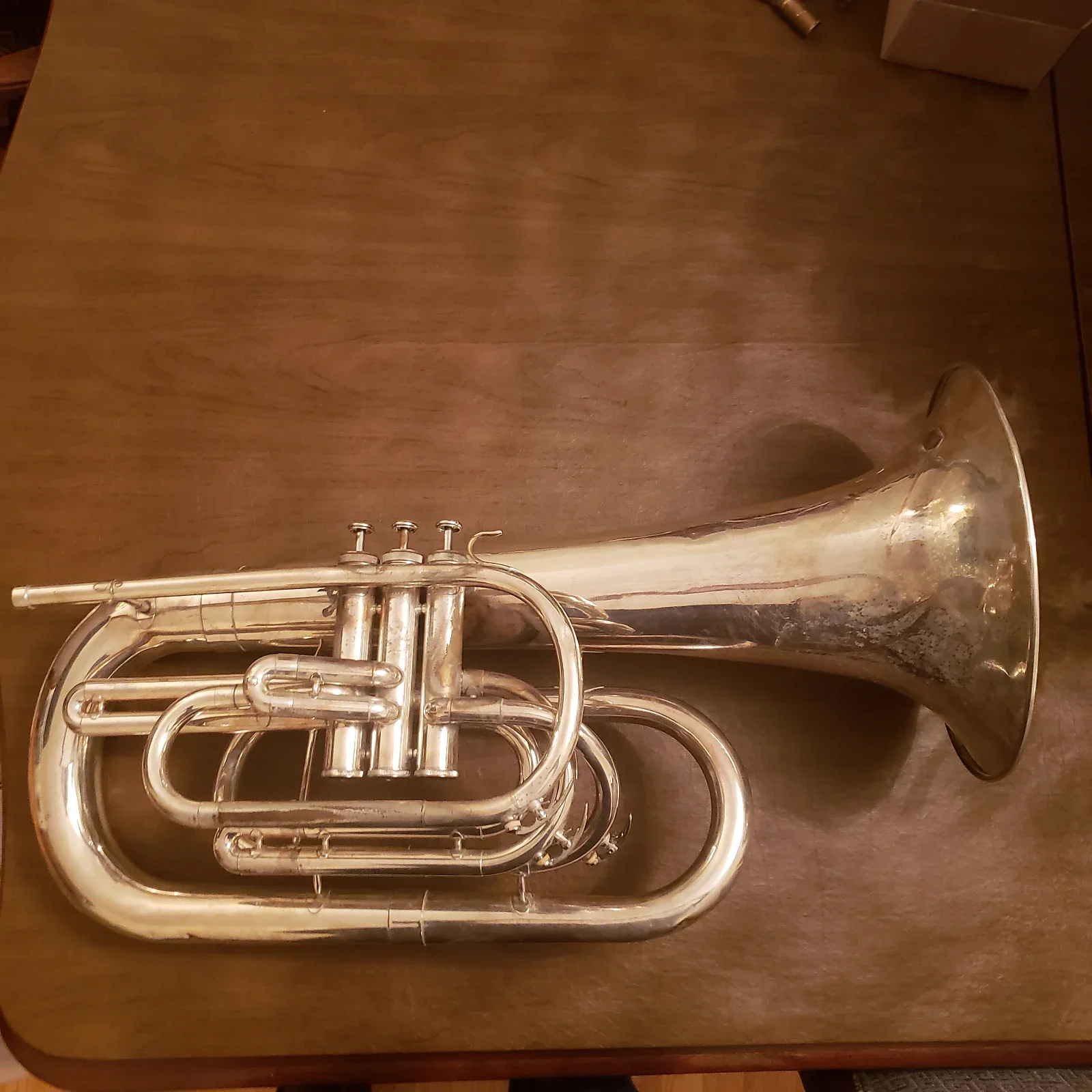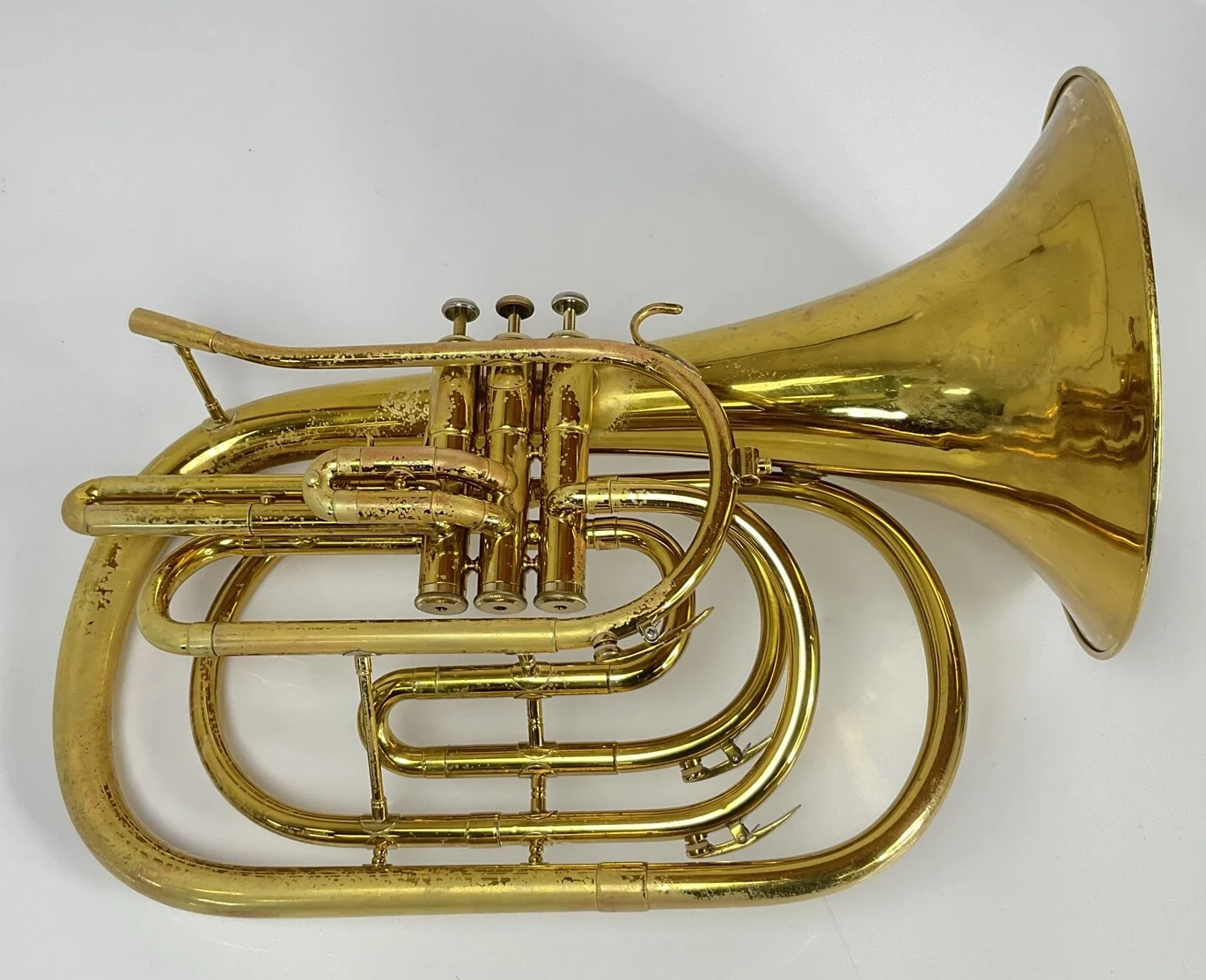G Bugles
If you’ve been wandering around my website and have noticed a fair bit of content regarding a bunch of weird bugles in G and want to know what that’s about, if you’re interested in G bugles and want to know which ones could be the most useful, or if you’re deep into the G bugle game and you just want to consume as much G bugle content as possible, this article is for you.
I’ll start with a very brief history lesson and a definition of what exactly a G “bugle” really is.
Civilian drum and bugle corps in the United States began after World War I, initially using actual valveless military bugles for the brass line. Eventually they started adding valves to the bugles, which were only allowed to be in the key of G. First came a single horizontal piston, then 1 piston and 1 rotor, 2 pistons, and finally 3 pistons. Each change came after a long and laborious process of arguing for and against The Tradition™, a drum corps pastime that continues to this day.
Along with valves, new brass voices were gradually added to the allowed instrumentation, and while many of them were not at all bugles, they were still called bugles. (For this reason I like referring to the “family” as a whole as competition bugles, rather than just bugles.) This resulted in fun names like “French horn bugle” and “trombonium bugle” that sound like they came from a Dr. Seuss book. Weird naming scheme aside, drum corps instrumentation was rife with experimentation until the year 2000, when the rules were changed to allow brass instruments in any key, instead of just G.
Drum corps is a pretty insular activity, and as a result most brass players who aren’t into drum corps don’t know much (if at all) about the G bugles. I myself never marched, and so my main interest in G bugles has always been “which of these instruments is useful outside of drum corps?”, and that’s mainly what this article is about. I have been fortunate to own a smattering of ultra-cool, ultra-rare G bugles in the past few years, and have used a few of them in very not-drum-corps environments, so I feel like I can answer that question pretty well at this point. If you are a G bugle collector, this information and advice probably does not apply to you. Let’s dive in!
Soprano Bugle
The soprano bugle was the top voice of the G hornline. These are essentially trumpets in G with an extra large bore and bell throat, and they are SCREAMERS. If that sounds appealing, you would probably enjoy a 2-valve soprano. The 2 valve horns are extremely light and extremely free-blowing, and if you’re playing screamer parts you don’t need the 3rd valve. Look for a King K-20 or Dynasty II.
However, I believe the soprano bugle’s real niche outside of drum corps is the LOW notes. Put an extra-large mouthpiece into a 3-valve soprano and you have an excellent G alto trumpet. With the huge scarcity of real alto trumpets in F or E-flat, a 3-valve G soprano bugle (which you can easily pick up online for around $200) is a legitimately useful tool for a trumpet player, or an interesting left-field choice for someone looking to add a high brass instrument to their stable.
While I would definitely recommend holding out for a 3-valve for the reasons above, an ultra-cheap 2-valve soprano is not a bad pickup either. It is fully chromatic at sounding E4 and above, which can still be useful (especially if you already have a trumpet). Just don’t spend very much!
Piccolo Soprano Bugle
These are an octave above the G soprano bugle, and are very rare. Almost all of them have two valves, making them chromatic only down to sounding E5. An interesting curiosity yet ultimately not worth looking for, especially as if one does show up for sale it will not be cheap.
Flugelhorn Bugle
Flugel bugles are not a common type of bugle, but they did see quite a bit of use in the 2-valve era. As the flugelhorn’s strength is the middle register and not the high register, I tend to think 2-valve flugel bugles are not very useful. That said, if you really want a flugelhorn and can’t find a dirt cheap one in Bb, a 2-valve G flugel bugle might be your cheapest way into a playable, nice-sounding flugelhorn. Do not show up to any kind of gig with one, but for home use and multitracking it can be a great option for the right price (no more than $200). You get the same lowest note (sounding E3) as a Bb flugel and just have 4 missing notes (Ab3-Bb3, Eb4) above that, but if you have any other mellow alto instruments that’s easy to write around. For 2-valve flugel bugles, look for the King K-30 or Dynasty II.
As for 3-valve flugelhorn bugles, they barely exist. Dynasty had one model, but it’s just a Signature 2000 Bb flugel with tubing added, which is not a good recipe. Kanstul did make at least one, but it was not a standard part of their catalog. Yamaha made a full set for the Blue Devils in 1992, but they were just modified Bb flugels. If you want a 3-valve flugel-like instrument, look to the alto bugle instead.
Alto Bugle
The alto bugle is usually a mellophone with a smaller bell, but the older ones (particularly the 2-valve Dynasty II Alto/Symphonic or the impossibly rare Dynasty III 3-valve version) are essentially big flugelhorns in G. A bit more horn-like when pushed, but otherwise all flugel. However, as the 2-valve is missing the same notes as a 2-valve flugel bugle (and is very rare), and the 3-valve I used to own is the only example I’ve seen of that model ever existing, these older (1970s) Dynasty alto bugles are not something to bet on.
The more common smaller bell mellophone type (King K-40 2-valve, Kanstul 175, later Dynasty II, later mellophone-wrap Dynasty III), is an interesting beast. With an alto horn mouthpiece, they sound like an even sweeter flugelhorn. However, they were usually designed around a marching mellophone mouthpiece, which means they can play far too flat to be usable when you use an alto horn mouthpiece. My early-pattern Kanstul KAB-175 was this way. I could only use a marching mellophone mouthpiece like it was designed for, and it played exceptionally well with that, but no longer sounded anything like a flugelhorn. Instead, the sound you get with that combination is more like a cross between mellophone and trumpet. It is certainly a unique and interesting sound, but not one that I would call useful. I’d love to hear it in a jazz combo or pop horn section, though.
Mellophone Bugle
The G mellophone bugle was originally inspired by the Conn 16E mellophoniums used in the Stan Kenton band, and the modern F marching mellophone was developed from the G mellophone bugle. With great F mellophones like the Yamaha YMP-204M readily available, is the G mellophone useful?
In my opinion, a G is useful only if you play a lot of screamer mellophone parts. I used to own a King K-50 2-valve G mellophone, the screamiest of all mellophones, and it was great fun to play screamer parts on. It is the sports car of the mellophone world. I eventually sold it because it didn’t offer enough of a difference from my other mellophones, but I had a ton of fun with it. If you can find a K-50 for a great price and want to give it a shot, I can guarantee you’ll have a great time with a K-50 or a 3-valve G mellophone (Dynasty or Kanstul) if you like playing very high on mellophone.
What I would not recommend is buying a G mellophone as your only mellophone. Get a good F marching mellophone, like a cheap King 1120 from eBay, so that you can have a workhorse that you can read existing mellophone or horn parts with. Then, if you want, pick up a G mellophone (2 or 3 valve) to add some more brightness and high note security to your mello arsenal.
Meehaphone
Kanstul MFL meehaphone
The meehaphone is the most famous of the weird and ultra-rare G bugles. Made for Kanstul for the Blue Devils in 1987, the meehaphone is essentially a bell-front descant horn in G with 2 valves. I was fortunate enough to own the only known meehaphone not in a museum for a while, and while it was very cool it was not very useful. The instrument’s forte is its middle register, with the high register being weak and unstable. But since it only has 2 valves, that middle register is only fully chromatic for less than an octave! A 3-valve meehaphone built from parts would be interesting, but if you’re doing that you’re in pretty deep.
French Horn Bugle
The French horn bugle was one of the standards of the DCI hornline in the 2-valve era, partly because it unlocked a lot of the missing pitches the mellophones had. Because it was built an octave lower than other mid-voice bugles, it was the only kind of bugle that really never needed 3 valves on the field. The lowest chromatic pitch (sounding E3) on a 2-valve “Frenchie” is far below what you would see in a typical drum corps French horn book.
However, because the French horn bugles were nearly as long as a single F horn, they were very easy to crack notes on while running across a football field. But are they useful off the field?
If you’re playing a live gig on multiple brass instruments where you are playing into a mic and need to cover some French horn parts, a marching horn is exactly what you need as the bell points the right way for the mic. But Bb marching horns exist and are plentiful, so why go for the G? Most of the time I would say you don’t need to, especially as 2-valve Gs don’t typically go for any cheaper than 3-valve King Bbs on eBay. However, the G really does sound very close to a concert horn, and the Bb is not as close. So if you want a really convincing horn sound for a mic placed in front of you, the G French horn bugle (King K-60, Dynasty II) could be your best bet.
While 2 valves is more than enough for field use, if you happen to come across one of the enormously rare 3-valve G French horn bugles (Kanstul KHB-185, Dynasty III) at a good price, that 3rd valve is obviously nice to have. That said, on the only gig I’ve had where I would have used my G French horn bugle if I had it at the time, I actually would have only needed 2 valves.
Low Alto Bugle
Kanstul low alto bugle
The low alto bugle is one of the oddest and rarest G bugles out there. It was made by Kanstul at the start of the short 3-valve era, and so few were made (6 total) that it didn’t even get a model number. It is essentially a Kanstul KHB-185 3-valve G French horn bugle with a trumpet shank, which sounds like it would just be a 185 but worse. However, the truth is much more interesting. Many kinds of mouthpieces will fit (trumpet, mellophone, alto horn, small trombone, French horn w/adapter), and the horn works very well with ALL of them. Each mouthpiece gives it a unique sound, like a cross between a French horn and whatever type of mouthpiece it is. Out of all the G bugles I’ve owned, the low alto might have the most potential. But since only 6 were made and at least 3 are spoken for, you’re very unlikely to come across one. If you want something like this, you might look into a Holton MH-100/101 Bb marching horn, which also has a trumpet leadpipe for some reason.
Trombonium Bugle
Dynasty II trombonium bugle
The award for the silliest name easily goes to the trombonium bugle, and it is also one of the silliest looking. It was made by Dynasty in 2 and 3 valve versions and small and large bells, and I can’t find any reason to recommend one over a normal Bb valve trombone or flugabone. They are also extremely rare, so you probably won’t have that choice to make anyway.
Cellophone
The cellophone is another impossibly rare G bugle. Essentially a Dynasty flugabone in G, only 4 2-valve models were made, all for the Phantom Regiment. However, 3-valve Dynasty III models were also made for the European market, but only 4 of those are known to exist. You’d have much better luck taking a Bb flugabone from King or Dynasty and lengthening it to G, or just playing a Bb flugabone.
Baritone Bugle
This is the low brass G bugle that you want. Originally called a “bass baritone” to distinguish it from the older and smaller type of baritone bugle, this kind of baritone bugle was the standard type of low brass in DCI hornlines from its inception until the end of the G bugles (at which point it was just replaced by the same thing in Bb). Most of them have 2 valves, and in my opinion they are not worth it for someone looking to use it in non-drum corps situations. You can get used Bb marching baritones very easily, and they will be much more useful. However, if you can find one of the much less common 3-valve G baritone bugles (Kanstul KBB-190, Dynasty III, Dynasty M371) for an affordable price, it can be an interesting purchase.
As your only low brass instrument for home use, the 3-valve G bari would be a nice option as it can play as high as a Bb instrument but can also play chromatically down to Db2. However, I would usually only recommend purchasing a G baritone as a second instrument to a Bb instrument (regardless of type), and it doesn’t bring THAT much new to the table. It has a nice fat sound that is different enough to a Bb marching baritone that it could be interesting to own both, but between baritone and euphonium I don’t think there’s much of a need for that G baritone sound. I think the most sensible use would be if you don’t want to put down the money for a 4-valve euphonium (and/or no $500 Yamaha YEP-321s are for sale at the time), but want something that can play lower than your 3-valve Bb instruments. But it would have to be a very good price on the G baritone, like $300 or less.
Euphonium Bugle
The G euphonium bugle is the baritone bugle’s big brother, and is one heavy beast. Pretty much everything I said about the baritone bugle above also applies to the G euph. I will say that Bb marching euphoniums are not nearly as common to find used for cheap as Bb marching baritones, so if you need a bell-front euphonium to play into a mic and happen to find a G euph bugle for cheap it could be a good solution. That said, G euphs are also not as common as G baritones (ESPECIALLY the rare 3-valve models by Kanstul or Dynasty), so it would have to be a lucky situation.
Contrabass Bugle
Generally, contrabass bugles are just Bb tubas that point forward and are crooked down to G. A 3 or 4-valve G contra is a cool beast, but not a cheap or useful one. In my opinion the only reason to buy a G contra would be if it was an older piston/rotor or 2 piston model being sold for nearly nothing, that you could get converted to a concert tuba with a front-action valve set in the same bore that you happen to have lying around. Otherwise, a normal tuba is a much better purchase.
Closing Thoughts
Sadly, the door is nearly shut on the G competition bugle. G bugles were quickly phased out of DCI competition after the any-key rule change in 2000, and the list of groups that still use G bugles is not a long one. The most notable is the United States Marine Band Commandant’s Own Drum & Bugle Corps, which very recently moved from 2-valve Kanstuls to 3-valve BACs. Other than that, there are some alumni and lower-level junior corps that are still on G, as well as a handful of small G-faithful corps in Japan, such as the Yokohama Scouts.
The only place to buy a new G bugle is from BAC in Kansas City. BAC acquired the Kanstul G bugle tooling when Kanstul shut its doors in 2019, which is why they made the new bugles for the Commandant’s Own. They do advertise the G bugles on their website catalog, but they price them at nearly twice what Kanstul did, making them far out of reach for most people who might be interested in one. Additionally, they only offer 4 out of Kanstul’s 10 bugle models, so if you want anything other than a soprano, mellophone, large baritone, or contra, you are probably out of luck.
Fortunately, the common types of G bugle were made in large quantities to outfit all the corps’ hornlines, so there is no shortage of used soprano, mellophone, French horn, baritone, and contrabass bugles to be found. Additionally, as they are all essentially obsolete and only desirable by DCI alumni and G bugle collectors, they usually go for very affordable prices. The 3-valve horns and less common types (alto, flugelhorn, euphonium) are harder to find, but if you are patient it is still doable. If you are diligent, you may even come across one of the ultra-rare models for a very low price. There are still unaccounted-for examples of nearly every kind of bugle ever made out there waiting to be found.
Marching French Horn
The marching French horn is an enigma. Sure, it’s been used by high school marching bands and drum and bugle corps, but there are very few recordings of them on the Internet. They also carry a bad reputation with them…they’re impossible to march with, they sound worse and not as loud as a mellophone, and are generally pointless. Or so people say.
Some of these claims do have some truth to them. Picking out pitches on a horn in Bb or low G with a narrow horn rim while running around a football field is certainly not easy, and the drum corps “Frenchie” lines earned notoriety for lots of cracked notes. The marching horn (regardless of key) also does fall short of the mellophone in terms of raw decibel output. Additionally, band directors often don’t know what to do with them. Do they read Bb parts or F? (The correct answer is F. Always F.) Are they worth the additional expense over a mellophone? Why do some have bent leadpipes and some don’t?
Despite all this, I think the marching horn is unfairly maligned. A good marching horn with the right player and mouthpiece behind it really does sound pretty close to a “real” horn, and you certainly can’t get that sound with a mellophone.
It is also important to understand the marching horn’s integral role in drum corps G bugle hornlines before the legalization of 3 valves. While mid-voice instrumentation in drum corps back then was full of experimentation, French horns were a common choice. Why? Because being twice as long as the G mellophones (or flugelhorns, alto bugles, or meehaphones) meant that they could access many crucial notes in the mid-register that simply did not exist on the other 2-valve alto instruments. This was huge for the arrangers of the time, and a good French horn line added a huge amount of depth and flexibility to a hornline.
However, the top corps had begun to streamline their mid-voice to just mellophones even before 3 valves were legalized in 1990. While the tonal colors of a varied mid-voice line were great, unifying to one type of instrument meant tuning and blend was much easier. That said, a few small French horn lines did survive briefly into the 3 valve era, most notably in the Cavaliers and Santa Clara Vanguard. Both lines used the Kanstul KHB-185 3-valve G French horn bugle, with 8 made for SCV and 6 made for the Cavaliers. It is likely that no other examples of the model were made (despite it remaining in the Kanstul catalog for most of the company’s life), which would mean there are only 14 in the world.
Here’s one!
This is the Kanstul KHB-185 I used to own, which was one of the Santa Clara Vanguard horns (it is even stamped as such on the bell!). SCV used these only through the 1992 season, after which they moved to all mellophones.
This horn is a great player. It is certainly not point-and-shoot like a mellophone; you have to work for the right notes just like on a single F horn (which is only a whole step lower). But the reward for your efforts is a bell-front instrument that really does sound like a French horn.
But don’t just take my word for it. Here’s a quick 8-part demo I recorded all on this Kanstul:
While the register of drum corps French horn parts meant that they really did not need a third valve, I certainly enjoyed getting to use the full range of the instrument in this bite-sized piece.
Being fully chromatic also means that an instrument like this could really be the solution for playing French horn into a mic that’s placed in front of you. I have played many gigs where I doubled on French horn, and the only solution with a normal horn is to physically turn 90 degrees to the left and hold the bell up the mic like you’re playing Mahler. It is awkward at best. This Kanstul (which sounds like a horn, but points forward) is the perfect solution for a gigging brass doubler. I do feel that more typical a Kanstul 285 Bb marching horn is a better compromise just for the fingerings; I (along with most brass improvisers) am much more comfortable improvising in Bb than G, and this is the reason why I ended up selling the the KHB-185. I have also played a recording session here in Los Angeles where everyone was on marching instruments and one of the mellophone players also played a Kanstul 285 on some cues, presumably to fatten up the section sound.
The only other non-marching band use of a marching horn I’ve seen is by the fabulous Solo Hornist of the Munich Philharmonic, Matias Piñeira. He has a custom small bell Bb marching horn, which appears to be an Otto 207 “La Revolución”, that he uses for salsa playing in addition to his normal Alexander 103. He uses both instruments in this video:
Here’s a brief trip through some other interesting types of marching French horns.
First up is the previously-mentioned Kanstul 285 marching horn in B-flat. While you could be forgiven for thinking that the Kanstul 185 marching horn in G above was based on the 285, it’s actually the other way around. Zig Kanstul started his company making G bugles only, so the Bb 285 is actually a derivative of the G. It has the same up-turned leadpipe to allow for a typical downstream horn embouchure while holding the horn above parallel. Other brands’ marching horns do not have this feature. The B-flat marching horn is the most common type of marching horn, and a few manufacturers (Yamaha, King, Adams) each have a model in their current lineup.
Kanstul also sold a high F marching horn, model 284. High F marching horns are not common, but they have been produced by Kanstul, Dynasty, and Blessing. Since Kanstul closed up shop in 2019, I don’t believe there are any high F marching horns currently being produced. The closest thing I know of is the King KMH611, which is basically just a mellophone with a horn receiver and thus not really a marching horn.
Before the Dynasty B-flat marching horn became the more modern M551, the early models used the same basic wrap as the Dynasty III G French horn bugle. The Adams MF1 has a similar wrap to the Dynasty M551, but the older DEG/Dynasty design doesn’t have any imitators that I’m aware of.
There have been some very odd-looking marching horns throughout history as well, such as the Holton MH-100, 101, and 102. These Dr. Seuss horns play as oddly as they look, but at the same time they play concerningly well. They have a trumpet mouthpiece shank for some reason, which allows you to put lots of different kinds of mouthpieces in it. Most inexplicably, they have been copied by Jinbao. Every aspect of this instrument’s existence seems like it came out of a fever dream! Unbeknownst to most, Yamaha also made a circular marching horn in the Holton style: the ultra-rare YHR-301M.
Feast your eyes on this glorious Hans Hoyer 4-valve Bb marching horn, which is possibly the only 4-valve marching horn ever made, and certainly one of the only professional-quality bell-front horns in existence. My desire for one of these knows no bounds.
Finally, a discussion about marching horns cannot ever be truly complete without discussing the Patterson Hornette project. This was an attempt to create a new kind of bell-front French horn for use by horn players in jazz and popular music, in a similar vein to the Otto 207 referenced above. Unfortunately, despite Conn-Selmer being linked to the hornette project, it has been radio silence since the 2022 IHS Symposium. Hopefully we will get updates soon!
The Patterson hornette
The Low Alto Bugle
Speaking of marching horns with trumpet shanks, Kanstul also made a very odd variant of the KHB-185 3-valve G French horn bugle presented at the beginning of the article. They called it a “Low Alto”, and it is the same as the KHB-185 except for a different leadpipe (trumpet shank) and main tuning slide arrangement. As weird as it is, 6 were built and it did see some drum corps use with the Marauders and later the Kingsmen Alumni.
Kanstul low alto bugle in G (no model number)
Because it has a trumpet shank, the low alto bugle can accept many different mouthpiece types. As I have adapters for both trumpet to horn and trumpet to cornet, I was able to see how it sounds with mouthpieces that use all 3 shanks. As it is a Kanstul G marching horn at heart, if you use a horn mouthpiece with an adapter it plays and sounds pretty much like the KHB-185 French horn bugle. It’s a little harder to play accurately and a little more work to get a centered horn sound (I suspect mostly due to the adapter), but it’s there if you work for it. And unlike the 185, the low alto has a whole toy chest of other sounds to explore by using different mouthpieces.
From my time with the low alto, I found that horn, tenor horn, alto trumpet, and very small trombone mouthpieces worked the best. I do think that a mouthpiece that truly matched the instrument well would have to be custom made. But rather than talking about it any longer, I’ll just let you listen. I recorded a small collection of short, improvised excerpts on 11 different mouthpieces (and adapters when required), each meant for a different instrument.
Lastly, here’s a back-to-back comparison of the 2 marching horns with trumpet shanks: the G low alto bugle with horn mouthpiece (via adapter) and the Holton MH-101 with horn mouthpiece (via adapter).

